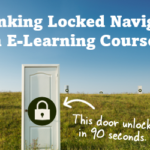A lot of what I see is not good. I wonder if rapid e-learning is just going to become like PowerPoint with a ton of messed up and boring training?
Myth 2: Rapid E-Learning Is A Second Class Product!
July 12th, 2007
In the first part of this series, we busted the myth that Rapid E-Learning Is Crapid E-Learning. Today, we’ll explore whether or not it’s the Cinderella of e-learning.
Even as many of the pundits acknowledge the value of rapid e-learning, they will assign a second class status to it as a training vehicle. They usually say that its value is limited to quick, just-in-time content that is more information-based than learning-focused. Since most organizations need training delivered in just a few weeks versus months, there’s some truth to that. However, it’s not a complete picture.
There’s always a need to do the quick, “down and dirty” training and rapid e-learning tools are great for that. However, the tools have changed and are empowering people in new ways. The tools are still easy to use, yet now are packed with features that empower non-multimedia developers to create engaging and interactive training courses.
At one point, the goal might have been to quickly convert a PowerPoint file and put it online, but today the tools allow you to build training courses that have a standard user interface and include the ability to add audio, video, and custom animations. This matches a lot of what you get when you buy vendor developed training. On top of that, you can create all sorts of interactive content. Just look at some of the weekly challenge modules to see what people are building.
On top of increased functionality, the output of the tools has become impressive. A great example is Rise. It is easy to use, and has a very polished and sophisticated feel. Imagine trying to custom build a similar product. It would cost thousands and take months to develop. It definitely would be outside the scope of most training courses. Not today. Rapid e-learning tools are making the trainers look like stars.

Next Generation Tools
Tools like Rise are just the first step. The next generation tools like Articulate 360 will give more power to the content owners and instructional designers to quickly build interactive training courses that not only meet the time needs of the organization, they’ll also have advanced interactions to create a more productive e-learning environment. Eventually, anyone who wants to design training will have the power to do so without the need for a flash programmer; and this training will rival the best of what you see today.
Leveraging the Tools to Make Your Courses First-Class
- Rapid development is already first class. Organization’s want performance that gets results. Training is one piece of that puzzle. Considering the cost of training and whether or not it really brings value, rapid development tools are very attractive. Their courses are built at a fraction of the cost, and traditional training methods are challenged to show that their more expensive approach brings greater return on the investment.
- Develop a coursel mindset. I like to think of coursels as “course morsels.” They are bite-sized chunks of information and learning. Instead of building large training programs, make your strategy to build a series of coursels that address very specific topics. With the coursels you can develop just-in-time material to address immediate needs. In addition, you can tie your coursels together to create whole courses. You can also use the coursels to blend with and augment other training in the organization.
- Look at the internet. The internet is changing the way we interact with information. The workplace is being filled with a whole generation of workers that expect to create and share content. Everyone in the organization is an expert in some capacity. In addition, there is greater demand for collaboration and knowledge transfer. Rapid development tools allow people to share what they know at the point of demand. There is an opportunity to use these tools as you explore effective informal learning strategies and the development of personal learning environments. This is an important consideration moving forward.
Rapid e-learning is a first class approach to training because is saves you time and money. Be creative. Learn to leverage the tools to build engaging and interactive training.
Next, we’ll explore the myth that empowering your subject matter experts with rapid e-learning tools is bad.
Events
- Everyday. Check out the weekly training webinars to learn more about Rise, Storyline, and instructional design.
Free E-Learning Resources
 |
 |
 |
|
Want to learn more? Check out these articles and free resources in the community. |
Here’s a great job board for e-learning, instructional design, and training jobs |
Participate in the weekly e-learning challenges to sharpen your skills |
 |
 |
 |
|
Get your free PowerPoint templates and free graphics & stock images. |
Lots of cool e-learning examples to check out and find inspiration. |
Getting Started? This e-learning 101 series and the free e-books will help. |
13 responses to “Myth 2: Rapid E-Learning Is A Second Class Product!”
Good blog post. I agree that it’s important to have smaller chunks of information. I like the coursels idea. I find that it’s hard to get my manager and customers to go with smaller courses, though. Everyone wants to build big courses. What do we do to get others to see the value in smaller courses or chunks?
I like rapid eLearning. It is fast and my projects are nice. I would like to have a rapid simulation tool or something where I can build games quickly.
I agree with you Doug. I’ve seen online pieces that are dull and boring… all it is, is a few powerpoint slides published onto LMS.
However, I’ve created a few online elearning pieces that is fairly attractive and interactive with the intended audience. The one thing i LOVE about articulate is the way you can incorporate flash movies into the online piece.
When you actually sit down and think about it, its fairly easy to whip up an excellent elearning piece.
Another thing i see lacking in our organisation, is that we haven’t really promoted the elearning approach yet… Or maybe this is just an issue in Australia??? Hopefully we will see the change in the coming months!
The term “coursel” is more appealing though it means same as “learning objects”. The “coursels” will not only help in building up the “Course” but also very useful for reusing and to meet the “need of the hour”. PowerPoint is a good tool for elearning and many need to unlearn that PowerPoint is only for “presentations”, another myth. When combined with “Articulate” one can develop a good elearning material with less expense and incorporating multimedia effects.
I am a corporate instructor and the following email sent to me today is indicative of what I hear weekly from employees taking my on-line (e-learning) classes through our company. THIS IS SOMETHING THAT CORPORATIONS SMALL AND LARGE MUST UNDERSTAND—PEOPLE WILL TAKE NON-COMPANY RELATED TRAINING ON THEIR OWN HAPPILY—THEY WILL TAKE COMPANY RELATED TRAINING ON THEIR OWN BEGRUDGIDLY!
The email follows:
I left the following comments on one of the surveys today:
I’m beginning to seriously question how effective online courses are at presenting material for long-term retention. Not specific to this class, but in general I’m having a hard time retaining the knowledge that is presented in the XX (Internal private course) program from one week to the next. It’s a lot of info and minimal reinforcement due to minimal interaction or exercises that use it. As the program has progressed, it’s really become more of an overview of material to reference on XXX’s (name withheld intentionally) capabilities vs. really teaching the capabilities which I believe was the original intent.
Maybe it’s just me, but as important as I know it is to understand XXX’s capabilities, I’m glad next week is the last session. The honest truth is that it takes a lot of discipline for me to focus on these classes. There’s a ton of very valuable information that’s been included in the CBLs (Computer Based Learning) and the WebEx sessions, it’s just info overload and keeping my attention focused in on it is a struggle. I’m honored to get to attend, but truthfully it’s boring. I guess I enjoy the interaction (more than just being asked questions or answering a quiz) and activity to reinforce what I’m being taught. I think the biggest thing that keeps me paying attention is the fear that I might get called on or answer a quiz wrong, but I find myself just memorizing what is said so I can regurgitate it. If you asked me questions about this morning’s session, I doubt I could answer. The fact that there is a test on it all at the end kind of scares me, but then again, I aced history & government in school not because I actually learned it, but because I could cram and memorize before the test. What day were the first shots of WWI fired? Exactly, but I’ll bet we both got it right on a test at some point in our education.
And I realize I’m raising problems without suggestions, sorry I’m just not sure how to make online classes overly effective with soooo much info covered. Maybe a podcast of the CBL’s to listen to on my commute and 5 minute previous week’s review in each session would also be helpful? I just know that I could walk a person through the PM (classroom with lab’s) process without a struggle and it’s been several years since I had an in-person class on it. I could also provide some key strategies for negotiation and sales process steps that I took out of the classes I attended earlier this year. But I couldn’t tell you the key service lines for XXX or XXX without going back to the CBLs or reference materials.
That’s probably way more honesty than you wanted, but I know you work hard on this and do a really good job so it’s only fair to be real about the program. That’s my $.02 but I’m not speaking for anyone but myself. The others might be a lot better students than me.
I agree that rapid elearning is probably more fitting for training in certain areas. With that being said, I think that there are many valid ways to learn. But I do believe that it needs to be balanced to reflect the nuances of everyday thought and not just in front of a computer screen. There needs to be approaches to learning that stimulate interesting conversations and topics. In general, e-learning consumers and frankly all serious Internet users are bombarded daily with fragmented information. This is a strikingly different process of thought than our ancestors had not been exposed to and this is evidenced by our use of all-access, surface level interaction with social media. Our minds need to evolve in some ways to handle the incoming barrage of data. There needs to be some thoughtful way of diving deep into data and make it transformative – make it a coherent mapping of ideas. In other words, being able to have educated discussions about the gray areas of whatever topic you can dream of. I can also see how this relates to working memory and neuroscience.
[…] […]
[…] Myth 2: Rapid E-Learning Is A Second Class Product! In the first part of this series , we busted the myth that Rapid E-Learning Is Crapid E-Learning . Myth 1: Rapid E-Learning Is Crapid E-Learning! In this series , we’ll look at some popular myths about rapid elearning. elearning: Blending social learning tools with rapid elearning to manage QA process – Wikis (v1) How to Create a Visual Design for Your E-Learning Scenario In a previous post, I wrote about a simple way to structure a scenario by using the 3C model . Build Branched E-Learning Scenarios in Three Simple Steps This post is in response to some conversations I had during the last ASTD conference in Washington, DC. Rapid e-learning TIC Clipart Présentations & Conversions Animation et Sons e-learning [+] Cathy Moore twine instructional creating eXe Learning logiciel example financer WIP4 boricua video Funzionario3puntozero esempi aperta oltre Visual Design trends color evaluating Prezi présentation objet presentation Books design michael guide Oltre il New Public Management second PowerPoint Tips video office create PowerPoint tutorial instructional Open Education source dumas universitaire Teacher Resources google handy stuff Tutorials custom Images1 microsoft Prezi online Rapid eLearning build narzędzia animated voxopop Resources google conference E-learning and Gamification examples rapid return Authoring Tools – Herramientas de autos digitales sound videoconferencing savor Fiber Optic : FFT something télécom LeWeb11 leweb other Intégration / Design crafted iosslider jquery Tools sketch Fonts legible websites Infographics unnamed exercise Design journal posts online Outils de design pédagogique instruction together Instructional Design Books graphics Outils divers tablefy MICROSOFT Innovative Tools windows Open Educational Ressources comp8440 stanford Python forums apprendre programmer The Current Web mobypicture coole INNOVATION massively Other projects of interest welcome openscout corto ELEARNING tools upside developing Outils payants mobile higher e-Learning Blogs multimedia corporate elearning Guides Rapid elearning, cours, présentations Articulate vs PowerPoint Tutoriels Articulate Studio et Storyline Logiciels auteurs Rapid e-learning jocegermain home • contact • blog • fb • twitter to experience pearltrees activate javascript. […]









0
comments